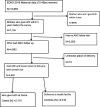Spatial clustering and determinants of home birth after at least one antenatal care visit in Ethiopia: Ethiopian demographic and health survey 2016 perspective
- PMID: 32046677
- PMCID: PMC7014695
- DOI: 10.1186/s12884-020-2793-6
Spatial clustering and determinants of home birth after at least one antenatal care visit in Ethiopia: Ethiopian demographic and health survey 2016 perspective
Abstract
Background: All pregnancies are at risk and have to be attended by skilled professionals. In Ethiopia however nearly half (45.7%) of the women were giving birth at home after antenatal care (ANC) visits in which skilled professionals were not available. Therefore, the aim of this study was to assess spatial clustering and the determinant factors of home delivery after antenatal care visits in Ethiopia.
Methods: A case control study was conducted on 2110 mothers who gave birth at home after ANC (cases), and 2510 mothers who gave birth at health institutions after attending ANC (controls), based on EDHS 2016 data. As per the recommendations of the DHS program, we weighed the data before analysis. ArcGIS 10.3 was used to show spatial pattern and SaTScan™ 9.4 to identify significant clusters. Stata 14 was used for data cleaning, weighing, and the analysis of the determinant factors. Bi variable and multi variable multilevel mixed effect logistic regression was fitted. Finally, the Log-likelihood ratio (LLR) and Relative risk with p-value of spatial scan statistics and AOR with 95% CI for significant determinant factors were reported.
Results: Home delivery after ANC was spatially clustered in Ethiopia (Moran's Index = 0.91, p-value< 0.01). Attending, 1-3 ANC visits (AOR = 1.41, 95%CI: 1.17-1.71), no information about birth preparedness plan (AOR = 2.21, 95%CI: 1.83-2.69), pregnancies wanted later (AOR = 1.55, 95%CI: 1.20, 2.06), not having health insurance (AOR = 2.16, 95% CI: 1.29, 3.62), Muslim (AOR = 1.57, 95% CI: 1.13, 2.19) and protestant (AOR = 1.72, 95%CI: 1.16, 2.42) religions were positively associated with home delivery; While being rich (AOR = 0.42, 95%CI: 0.32-0.54), middle wealth index (AOR = O.66, 95%CI: 0.51, 0.86), primary education (AOR = 0.45, 95%CI: 0.36-0.55), secondary education (AOR = 0.11, 95%CI: 0.07-0.16), above secondary education (AOR = 0.06, 95%CI: 0.03-0.11) were negatively associated.
Conclusions: Home delivery after ANC follow ups was spatially clustered. Socio-demographic, health service and pregnancy related factors determined the prevalence of home delivery after antenatal care visits. Strengthening women's education, ANC visit, giving more information about birth preparedness plan, and improving family wealth are vital to reduce home delivery after antenatal care visits.
Keywords: Antenatal care; Ethiopia; Home delivery; Spatial distribution.
Conflict of interest statement
The authors declare that they have no competing interests.
Figures






Similar articles
-
Spatial distribution and associated factors of dropout from health facility delivery after antenatal booking in Ethiopia: a multi-level analysis.BMC Womens Health. 2023 Feb 23;23(1):79. doi: 10.1186/s12905-023-02229-y. BMC Womens Health. 2023. PMID: 36823622 Free PMC article.
-
Spatial variation and factors associated with home delivery after ANC visit in Ethiopia; spatial and multilevel analysis.PLoS One. 2022 Aug 25;17(8):e0272849. doi: 10.1371/journal.pone.0272849. eCollection 2022. PLoS One. 2022. PMID: 36007083 Free PMC article.
-
Spatio-temporal distribution and associated factors of home delivery in Ethiopia. Further multilevel and spatial analysis of Ethiopian demographic and health surveys 2005-2016.BMC Pregnancy Childbirth. 2020 Jun 3;20(1):342. doi: 10.1186/s12884-020-02986-w. BMC Pregnancy Childbirth. 2020. PMID: 32493302 Free PMC article.
-
The effect of lack of ANC visit and unwanted pregnancy on home child-birth in Ethiopia: a systematic review and meta-analysis.Sci Rep. 2022 Jan 27;12(1):1490. doi: 10.1038/s41598-022-05260-5. Sci Rep. 2022. PMID: 35087152 Free PMC article.
-
Predictors of Birth Preparedness and Complication Readiness Practices Among Pregnant Women in Ethiopia, a Systematic Review and Meta-Analysis.Int J Public Health. 2024 Sep 2;69:1607296. doi: 10.3389/ijph.2024.1607296. eCollection 2024. Int J Public Health. 2024. PMID: 39286757 Free PMC article.
Cited by
-
Spatial variation and determinant of home delivery in Ethiopia: Spatial and mixed effect multilevel analysis based on the Ethiopian mini demographic and health survey 2019.PLoS One. 2022 Mar 11;17(3):e0264824. doi: 10.1371/journal.pone.0264824. eCollection 2022. PLoS One. 2022. PMID: 35275944 Free PMC article.
-
Trends, spatial distribution and determinants of maternal home deliveries in Zambia.BMC Pregnancy Childbirth. 2025 Apr 10;25(1):422. doi: 10.1186/s12884-025-07393-7. BMC Pregnancy Childbirth. 2025. PMID: 40211161 Free PMC article.
-
Determinants of place birth: a multinomial logistic regression and spatial analysis of the Ethiopian mini demographic and health survey data, 2019.BMC Pregnancy Childbirth. 2022 Jul 8;22(1):553. doi: 10.1186/s12884-022-04880-z. BMC Pregnancy Childbirth. 2022. PMID: 35804305 Free PMC article.
-
Wealth-related inequality in vitamin A rich food consumption among children of age 6-23 months in Ethiopia; Wagstaff decomposition of the 2019 mini-DHS data.PLoS One. 2024 Oct 8;19(10):e0302368. doi: 10.1371/journal.pone.0302368. eCollection 2024. PLoS One. 2024. PMID: 39378195 Free PMC article.
-
Geographical clustering and geographically weighted regression analysis of home delivery and its determinants in developing regions of Ethiopia: a spatial analysis.Emerg Themes Epidemiol. 2022 Aug 19;19(1):8. doi: 10.1186/s12982-022-00117-8. Emerg Themes Epidemiol. 2022. PMID: 35986295 Free PMC article.
References
-
- World Health organization, Department of Maternal N, Child and adolescent health . Family, Women’s and Children’s Health Integrated Management Of Pregnancy And Childbirth. 2 2017.
-
- Global health obseervatory. Skilled birth attendant situations and trends. 2018. https://www.who.int/gho/maternal_health/skilled_care/skilled_birth_atten....
-
- WHO . SWIZERLAND Department of Maternal, Newborn, Child and Adolescent Health. 2018. WHO recommendations Intrapartum care for a positive childbirth experience. - PubMed
-
- WHO . WHO media center. 2016. maternal mortality fact sheet 2016.
-
- Kassebaum NJ, Barber RM, Bhutta ZA, Dandona L, Gething PW, Hay SI, et al. Global, regional, and national levels of maternal mortality, 1990–2015: a systematic analysis for the global burden of disease study 2015. Lancet. 2016;388(10053):1775–1812. doi: 10.1016/S0140-6736(16)31470-2. - DOI - PMC - PubMed
MeSH terms
LinkOut - more resources
Full Text Sources
Medical
Research Materials

